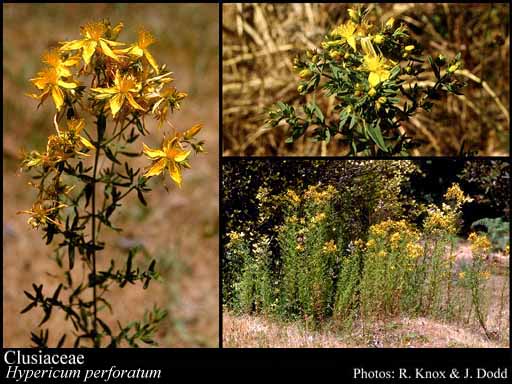- Reference
- Intr.Nat.Syst.Bot. 74 (1836)
- Name Status
- Current







Scientific Description
Common name. Mangosteen Family.
Habit and leaf form. Trees, shrubs, herbs, lianas, and herbaceous climbers; with coloured juice (this resinous), or non-laticiferous and without coloured juice; bearing essential oils, or without essential oils; resinous, or not resinous. Young stems of herbs cylindrical, or tetragonal, or oval in section (often ridged). Self supporting, or epiphytic, or climbing. Mesophytic. Leaves opposite, or whorled; ‘herbaceous’, or leathery; petiolate to sessile; gland-dotted (commonly, conspicuously), or not gland-dotted; without marked odour; simple; epulvinate. Leaf blades entire; pinnately veined; cross-venulate. Leaves without stipules. Leaf blade margins entire. Leaves without a persistent basal meristem. Stem anatomy. Nodes unilacunar. Secondary thickening developing from a conventional cambial ring (mostly), or anomalous (? — Endodesmia).
Reproductive type, pollination. Fertile flowers hermaphrodite, or functionally male and functionally female, or functionally male, or functionally female, or hermaphrodite, functionally male, and functionally female (etc.). Unisexual flowers present, or absent. Plants hermaphrodite (Hypericaceae s. str.), or monoecious, or andromonoecious, or gynomonoecious, or dioecious, or polygamomonoecious.
Inflorescence and flower features. Flowers solitary (rarely), or aggregated in ‘inflorescences’; in cymes, in umbels, and in panicles. The terminal inflorescence unit cymose. Inflorescences terminal; cymose, often umbellate or paniculate. Flowers bracteolate (the two bracteoles often close up under the calyx and not clearly distinguishable from it), or ebracteolate; medium-sized, or large; regular; cyclic, or partially acyclic (often partially spiral). Commonly the perianth acyclic, or the androecium acyclic, or the perianth acyclic and the androecium acyclic. Free hypanthium absent. Hypogynous disk absent, or present; of separate members. Perianth with distinct calyx and corolla, or sequentially intergrading from sepals to petals; 4–12(–20); 2 -whorled (if whorled); free. Calyx generally 2–6; 1 -whorled; polysepalous, or gamosepalous (basally); imbricate; regular. Corolla 2–6 (-14); 1 -whorled; polypetalous, or gamopetalous (sometimes basally connate); imbricate, or contorted; regular; yellow, or white. Petals clawed, or sessile. Fertile stamens present, or absent (in female flowers). Androecium 3–4 (rarely), or 20–100 (i.e. usually ‘many’). Androecial members branched (usually, apparently), or unbranched. Androecial sequence determinable, or not determinable. Androecial members when many (i.e. usually), maturing centrifugally (the members individually, those within bundles, and the bundles themselves); free of the perianth and adnate, or free of the perianth; free of one another, or coherent (often grouped into bundles, the latter opposite and sometimes adnate to the corolla, sometimes united into a tube or even united at their apices); 2–5 - adelphous (when in separate bundles), or 1 - adelphous (when A united into a tube). The androecial groups when present, opposite the petals. Androecial members 1 -whorled, or 2 -whorled, or 3 -whorled (or spiralled). Androecium exclusively of fertile stamens, or including staminodes (commonly the outer members staminodal). Staminodes when present, 2–50 (i.e. few to ‘many’). Stamens (3–)5–100 (usually ‘many’); diplostemonous (rarely), or triplostemonous to polystemonous (usually); when bundled, alternisepalous. Anthers separate from one another (usually), or cohering (occasionally); dehiscing via longitudinal slits; introrse (usually), or extrorse (rarely); bisporangiate. Pollen shed in aggregates (e.g. Kielmeyera), or shed as single grains; when aggregated, in tetrads. Fertile gynoecium present, or absent (in male flowers). Gynoecium (1–)3 carpelled, or 5(–13) carpelled (or more). The pistil 1–13 celled. Gynoecium syncarpous; synovarious, or synstylovarious, or eu-syncarpous; superior. Ovary unilocular, or plurilocular; 1(–3) locular, or 5(–13) locular (as many locules as G, or unilocular by intruded placentae failing to reach the middle). Gynoecium stylate, or non-stylate. Styles when present, 1, or 3, or 5(–13); partially joined; attenuate from the ovary; apical. Stigmas 1, or 3, or 5(–13); sometimes peltate; wet type; non-papillate; Group IV type. Placentation when ovary unilocular (i.e. rarely), parietal (on intruded placentae); usually axile. Ovules (1–)2–50 per locule (i.e., to ‘many’); horizontal, or ascending; arillate (often), or non-arillate (Hypericaceae s. str.); anatropous, or hemianatropous.
Fruit and seed features. Fruit fleshy, or non-fleshy; dehiscent, or indehiscent; a capsule, or a berry, or a drupe. Capsules septicidal. Seeds non-endospermic; winged, or wingless. Embryo rudimentary at the time of seed release to well differentiated. Cotyledons 2 (sometimes reduced). Embryo chlorophyllous (2/6); straight to curved. Seedling. Germination phanerocotylar, or cryptocotylar.
Geography, cytology, number of species. World distribution: cosmopolitan. X = 7, 8, 9, 10. 1000 species.
Economic uses, etc. Edible fruit from Garcinia (mangosteen), Mammea (mammee apple, mamey).
Keys
Western Australian Genera and Families of Flowering Plants — an interactive key
T.D. Macfarlane, L. Watson, N.G. Marchant